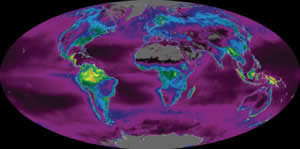
The relationship between UV levels and their negative impact on aquatic ecosystems works both ways.
A United Nations report into ozone layer depletion and its impact on aquatic ecosystems reveals wider links between UV levels and global warming.
Marine and freshwater organisms could be facing damage due to increasing UV levels, according to the UN commissioned review. Aquatic ecosystems produce over half the biomass of the Earth and are an integral part of the planet's biosphere. The international team behind the review is worried that our depleted ozone layer now exposes these ecosystems to harmful levels of UV radiation, particularly in polar regions where the ozone layer is thinnest.
But, the review also underlines the complex relationship between elevated UV levels and wider climate change. If UV damage cuts marine ecosystem productivity, the oceans' capacity to mop up the greenhouse gas carbon dioxide would fall. This extra atmospheric CO2 would add to global warming.
The relationship also works the other way. The annual phytoplankton bloom, which supports the entire Antarctic aquatic food chain, is currently protected from UV damage by a layer of sea-ice. Warmer climates would mean the sea-ice melts earlier, increasing the phytoplanktons' UV exposure. Research shows that plankton in such cold water are particularly vulnerable to UV damage, as the low temperatures slow their repair mechanisms.
Botanists Donat-Peter Häder of the Friedrich-Alexander University in Erlangen, Germany and former colleague H Kumar, now at Banaras Hindu University in Varanasi, India, worked with US scientists Ray Smith of University of California, Santa Barbara, and Rob Worrest of Columbia University in New York to compile the review. The team collected data from hundreds of separate studies into the effects of UV radiation on a diverse range of aquatic organisms, from plankton to frogs and fish. The findings highlight that, while the effects of UV radiation on entire ecosystems are difficult to measure and model, the impact on individual species can be dramatic.
Numbers of frogs, toads and other amphibians have fallen across the world over the last 10 years. While the exact cause seems to be a complex combination of factors, the review points to over 50 research papers implicating UV radiation as one of these, although the area remains contentious. Amphibians with malformations have been seen across the globe since the 1990s. Lab research on leopard frogs shows that larvae exposed to elevated UV levels can lead to malformed adult frogs. The real world effects are hard to quantify; subsequent field research revealed the frogs were spawning in areas well-protected from UV light by overhanging plants and by dissolved organic content in the water.
The review forms part of a wider United Nations Environmental Program (UNEP) report on interactions between ozone depletion and climate change. Every few years, the UNEP produces a report for parties to the Montreal Protocol - the 1987 international agreement to phase out production of most ozone-depleting compounds, such as chlorofluorocarbons (CFCs), by 2000. The report is subsequently published in Photochemical & Photobiological Sciences, to make it available to the entire scientific community.
'It is hoped that the publication will stimulate the scientific community to continue working on the gaps in knowledge that still exist,' said Janet Bornman, co-Chair of the Environmental Effects Assessment Panel of the UNEP and coordinator of the report. 'We hope that it will help keep scientists aware of their involvement in the protection of the environment for all forms of life on Earth,' she said.
